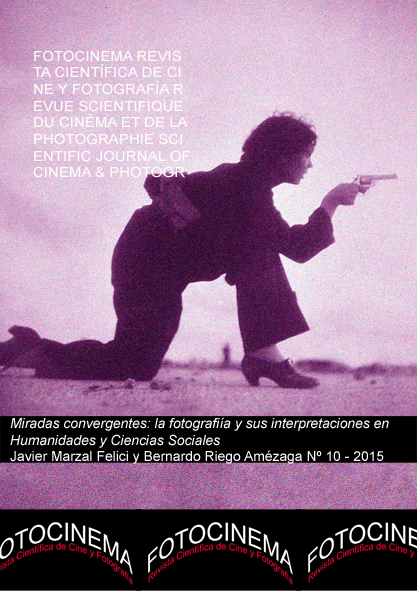¿Puede la fotografía mostrar lo inimaginable? El debate en torno a la representación de la shoah
DOI:
https://doi.org/10.24310/Fotocinema.2015.v0i10.5986Abstract
Resumen:Durante años, las imágenes fotográficas de la guerra y el horror han sido acusadas de los peores pecados: de ser incapaces de representar el dolor; de provocar una fascinación fetichista y voyeur; de simplificar el sufrimiento, de volverlo hermoso, de perpetuarlo; de prolongar la vergüenza de las víctimas, de explotarlas; de herir la sensibilidad de los espectadores, de anestesiarlos, etc.
Este trabajo sale en su defensa, para lo que propone profundizar en el debate en torno a la representación del Holocausto y la legitimidad de mostrar lo inimaginable que comenzó Theodor Adorno, avivaron Georges Didi-Huberman, Gerard Wajcman y Claude Lanzmann, y perpetuaron muchos otros.
Abstract:
For years, the photographic images of war and horror have been accused of the worst sins: of being unable to represent the pain; of causing a fetishistic and voyeuristic fascination; of simplifying the suffering, of making it beautiful, of perpetuating it; of prolonging the embarrassment of the victims, of exploiting them; of hurting the sensibility of their viewers, of anesthetizing them, etc.
This work comes to their defense, for which it proposes further debate on the representation of the Holocaust and the legitimacy of showing the unimaginable started by Theodor Adorno, fueled by Georges Didi-Huberman, Gerard Wajcman and Claude Lanzmann, and perpetuated by many other.
Palabras clave:Fotografía; representación; Holocausto; Shoah; Miller; Bourke-White.
Keywords:
Photography; representation; Holocaust; Shoah; Miller; Bourke-WhiteDownloads
Metrics
Publication Facts
Reviewer profiles N/A
Author statements
Indexed in
-
—
- Academic society
- N/A
- Publisher
- Universidad de Málaga
Downloads
Published
How to Cite
Issue
Section
License
All contents published in Fotocinema Revista científica de cine y fotografía are protected under the Creative Commons Attribution-NonCommercial-ShareAlike 4.0 International (CC BY-NC-SA 4.0) license. All about this license is available in the following link: <http://creativecommons.org/licenses/by-nc-sa/4.0>
Users can copy, use, redistribute, share and exhibit publicly as long as:
- The original source and authorship of the material are cited (Journal, Publisher and URL of the work).
- It is not used for comercial purposes.
- The existence of the license and its especifications are mentioned.
There are two sets of authors’ rights: moral and property rights. Moral rights are perpetual prerogatives, unrenounceable, not-transferable, unalienable, imprescriptible and inembargable. According to authors’ rights legislation, Fotocinema. Revista científica de cine y fotografía recognizes and respects authors moral rights, as well as the ownership of property rights, which will be transferred to University of Malaga in open access. The property rights are referred to the benefits that are gained by the use or the dissemination of works. Fotocinema. Revista científica de cine y fotografía is published in an open access form and it is exclusively licenced by any means for doing or authorising distribution, dissemination, reproduction, , adaptation, translation or arrangement of works.
Authors are responsable for obtaining the necessary permission to use copyrighted images.














13.png)



